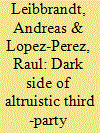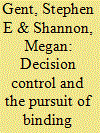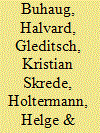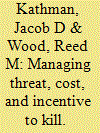|
|
|
Sort Order |
|
|
|
Items / Page
|
|
|
|
|
|
|
| Srl | Item |
| 1 |
ID:
107970


|
|
|
|
|
| Publication |
2011.
|
| Summary/Abstract |
The concept of networks has become synonymous with terrorism in recent years. Despite the abundance of material engaging the concept of terrorist networks, there is a paucity of research that applies analytic network methods to the empirical study of observed data. This article fills that void by comparing two arguments about terror network structure using a newly released attack network data set. One account suggests that terrorists purposefully structure their networks to maximize operational security (OPSEC) by minimizing connections, while an alternate proposition relies on findings in network sciences showing that many networks have a few well-connected individuals (referred to as scale-free structure). Empirical analysis of six evolving attack networks produces results contradicting both assertions. This article then looks beyond structure to examine whether there are any causal relationships between network characteristics and output, specifically attack casualties. The article concludes by examining possible drivers of network structure and pertinent policy implications.
|
|
|
|
|
|
|
|
|
|
|
|
|
|
|
|
| 2 |
ID:
107969


|
|
|
|
|
| Publication |
2011.
|
| Summary/Abstract |
This article experimentally studies punishment from unaffected third parties in ten different games. The authors show that third-party punishment exhibits several features that are arguably undesirable. First, third parties punish strongly a decider if she chooses a socially efficient or a Pareto efficient allocation and becomes the richest party as a result. Interestingly, this form of punishment is especially pronounced in women and more left-wing participants. Second, third parties punish strongly a decider if she chooses an equitable allocation and becomes the richest party as a result. Finally, third parties considerably punish passive parties who make no choice, especially if the latter are richer than the third party. Implications of these findings for social theory are discussed.
|
|
|
|
|
|
|
|
|
|
|
|
|
|
|
|
| 3 |
ID:
107967


|
|
|
|
|
| Publication |
2011.
|
| Summary/Abstract |
International relations scholars have garnered a good deal of evidence indicating that binding arbitration and adjudication are highly effective means for brokering agreements and ending conflict. However, binding third-party conflict management is rarely pursued to resolve interstate disputes over contentious issues like territorial or maritime control. While states value the effectiveness of binding procedures, they are reluctant to give up the decision control necessary to submit to arbitration or adjudication. The authors identify three factors that influence the willingness of states to give up decision control: issue salience, availability of outside options, and history of negotiations. An analysis of attempts to settle territorial, maritime, and river claims reveals that disputants are less likely to use binding conflict management when they have a greater need to maintain decision control.
|
|
|
|
|
|
|
|
|
|
|
|
|
|
|
|
| 4 |
ID:
107971


|
|
|
|
|
| Publication |
2011.
|
| Summary/Abstract |
Income varies considerably within countries and the locations where conflicts emerge are rarely typical or representative for states at large. Yet, most research on conflict has only examined national income averages and neglected spatial variation. The authors argue that civil conflicts are more likely to erupt in areas with low absolute income, even if a country's gross domestic product (GDP) per capita is not necessarily low, and in areas with large deviations from national averages. The authors test these hypotheses empirically using spatially disaggregated data on the location of conflict outbreaks and per capita income estimates. The authors find that areas with absolute poverty indeed see more outbreaks of conflict, and they find some evidence that inequality increases the risk of conflict. Subnational information can improve on conventional country-based measures and help our understanding of how local features and variation can give rise to mobilization and violence.
|
|
|
|
|
|
|
|
|
|
|
|
|
|
|
|
| 5 |
ID:
107968


|
|
|
|
|
| Publication |
2011.
|
| Summary/Abstract |
How do third-party interventions affect the severity of mass killings? The authors theorize that episodes of mass killing are the consequence of two factors: (1) the threat perceptions of the perpetrators and (2) the cost of implementing genocidal policies relative to other alternatives. To reduce genocidal hostilities, interveners must address these factors. Doing so requires that interveners alter the genocidaire's expectation of a successful extermination policy, which in turn requires a demonstration of the third party's resolve. This cannot be achieved immediately upon intervention, and, given the perpetrator's strategic response to third-party involvement, the authors expect intervention to increase hostilities in the short term. With time, however, the authors contend that the characteristics of impartial interventions offer the greatest opportunity for reducing the violence in the long term. A statistical analysis of the 1955-2005 period supports the theoretical expectations.
|
|
|
|
|
|
|
|
|
|
|
|
|
|
|
|
| 6 |
ID:
107966


|
|
|
|
|
| Publication |
2011.
|
| Summary/Abstract |
This article explores the impact of time pressure on negotiation processes in territorial conflicts in the post-cold war era. While it is often argued that time pressure can help generate positive momentum in peace negotiations and help break deadlocks, extensive literature also suggests that perceived time shortage can have a negative impact on the cognitive processes involved in complex, intercultural negotiations. The analysis explores these hypotheses through a comparison of sixty-eight episodes of negotiation using fuzzy-set logic, a form of qualitative comparative analysis (QCA). The conclusions confirm that time pressure can, in certain circumstances, be associated with broad agreements but also that only low levels of time pressure or its absence are associated with durable settlements. The analysis also suggests that the negative effect of time pressure on negotiations is particularly relevant in the presence of complex decision making and when a broad range of debated issues is at stake.
|
|
|
|
|
|
|
|
|
|
|
|
|
|
|
|
|
|
|
|
|